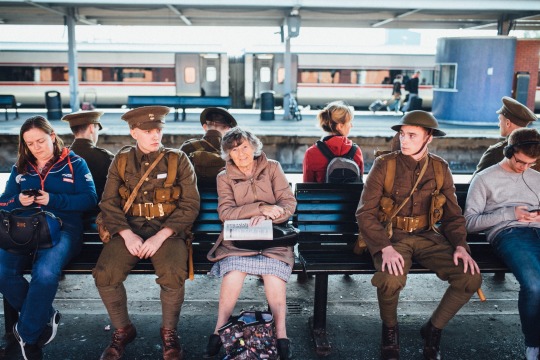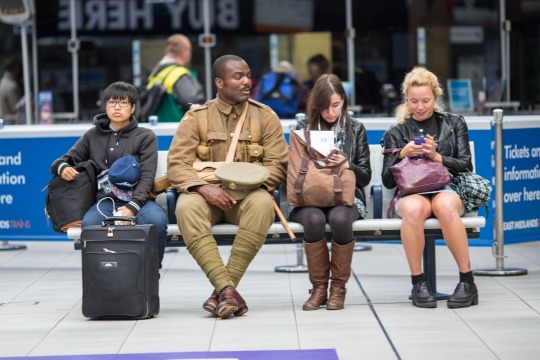you can have some wwi repression... as a treat | marie; twentysomething; still obsessed with 1917 i guess | icon by @kitdfox
Don't wanna be here? Send us removal request.
Photo

British wounded men are tended by medical staff as they lie on stretchers on the grass at an advanced dressing station near Boesinghe. 31 July, 1917
188 notes
·
View notes
Text



this next one's called "i have nothing to post so heres some from last week"
247 notes
·
View notes
Photo


Jul 3 1916 During the Battle of the Somme, Ernest Brooks takes this photo, IWM Q 758, during the Battle of Albert.
British infantrymen give a helping hand to wounded German prisoners near La Boisselle on 3 July 1916. They are both wearing their equipment in ‘fighting order’. One has an additional bandolier of ammunition, and each has an anti-gas PH (phenate hexamine) helmet in a small bag hung at the front. A first day objective, La Boisselle fell on 4 July.
July 3 1916-07-03
Colourization by julius.colorization
71 notes
·
View notes
Note
So this is random but I was wondering. When you were talking about your re-enactment kit you mentioned an identification bracelet. I was curious if 1. What wrist was it worn on (if there was a requirement on which ) and 2. Do you know if a soldier would wear one and a dog tag or just one or the other? Of course it was up to personal choice I imagine but I just got curious because I’d never heard of them before. Thank you!
So I can only speak for the British ID discs in WWI, since I haven’t done research into anyone else on that particular subject. This is actually quite a hard subject to research since so little info is available about the practice.
I’ve never stumbled upon a requirement for which wrist the bracelet was supposed to be worn on because the bracelet was an unofficial method of ID, and came about due to a lack of a two disc identification system which created problems with identifying bodies post-mortem.
The first official design for an ID disc, an aluminum circular tag, was to be worn around the neck, beginning in 1907, but began to filter out of issuing around the start of WWI (however, excess stock of the single metal discs were still being used up, and it’s possible for a WWI soldier enlisted pre-1916 to have one). Replacing this metal disc in 1914 was a single fibre disc, a bit of a brownish colour. Regulations throughout the war required a disc to be brought back after a soldier died for recording the death, but a one disc system left bodies without adequate means of telling whose body it was once the disc was removed.
This is where the commonly seen green and red disc necklaces—made of vulcanised asbestos—were issued in 1916 and to be worn instead and were seen as the standard method of ID (pic below).

The first was a green octagonal disc stamped with personal info and the second red circular disc, stamped with identical info, was to be attached from a shorter cord off the green. The red would be clipped from the body if a soldier were to die to bring back and confirm the death, while the green was left on the soldier.
But because the requirements kept changing and early war discs were still being issued halfway into the war, there was still a ton of confusion surrounding IDing bodies issued a single disc. “We have all these tags from the bodies, but which body is which?”
The aluminum plate bracelets came into practice when a second disc was not provided. The were privately purchased/made, sometimes with great care of engraving method, but more often than not, just crudely stamped into the soft metal. A shortage of stamps even led some soldiers to have a second disc on their person written upon with ink which would quickly wear away and basically be useless, and eventually became prohibited. The stamped bracelets assured soldiers would have their info attached somewhere on their body when their single issue disc was taken for recording their death in the event they died.
In short: if a soldier was issued only a SINGLE disc to be removed upon death, he most likely would have sought out a way to have a type of ID, like a bracelet, attached to him so they would know who he was after his necklace was removed. Some soldiers did not seek out the second form of ID to be kept on his body however, and this could lead to body ID confusion later.
If a soldier was issued with TWO discs, namely the red and green fibre discs starting in 1916, to have a bracelet would then be redundent, since the only reason to have a bracelet/privately made second disc was so there would be some form of identity left on your body, which in this scenario is of course covered by the green disc. However, I’d say nothing is stopping anyone from having two discs and a bracelet depending on personal circumstance. Someone could’ve updated their single disc to a two disc and simply kept the bracelet.
In the film 1917 (which maybe prompted you to ask? :P) Lance Corporal Blake is wearing a two disc necklace AND a metal bracelet. Schofield removes the red disc for admin to record Blake’s death, and Blake now has two pieces of ID left on his body: the green disc, and his aluminum ID bracelet.
Hope that could make sense!
102 notes
·
View notes
Text
@bobbole’s amazing “You Don’t Remember the Somme?” art reminded me of Jeremy Deller’s art “We’re Here Because We’re Here” which I actually had the privilege of stumbling across in person when I was in Manchester in July 2016.
It’s Remembrance Weekend here so I thought I’d go down memory lane a little… (none of the photos are mine btw)




The ‘art’ included about 1,600 male volunteers, all dressed in the uniforms worn by the British army in the First World War. Each man represented a named individual who had been killed on the first day of the Battle of the Somme (1st July 1916). When approached by the public, the men would hand out a card bearing the name, battalion and, often, the age of the man they represented. In Deller’s words, these cards were “like small tombstones”.
Every so often, the men would sing “We’re Here Because We’re Here” which was put to the tune of Auld Lang Syne.

I still get chills just remembering.
11K notes
·
View notes
Photo

Me: but dude, you were literally sitting next to each other and have obviously been lovers friends for some time. WHO THE HELL DID YOU EXPECT HIM TOO CHOOSE?!?
69 notes
·
View notes
Photo





… Who am I to understand what have I become? . . Sabaton, ‘Great War’
244 notes
·
View notes
Text

Or, alternatively

102 notes
·
View notes
Photo

practicing painting
1K notes
·
View notes
Photo

There’s a medal in it, for sure! Nothing like a scrap of ribbon to cheer up a widow.
Alternatively, the night the River Somme ran red.
Enjoy Leslie.
120 notes
·
View notes
Photo

Soldiers say goodbye to wounded comrades leaving a casualty clearing station. The wounded are on the way to England for further treatment and convalescence. British, Canadian, and other Commonwealth soldiers described England as “Blighty,” and also used it to indicate the non-fatal wound that would take you there. “Blighty” was therefore both “homeland” or “country” and, for soldiers in the field, a darkly humorous reference to non-fatal wounds leading to time spent far from the front. The word itself is an Anglicized version of the Hindi for “native land,” adopted by British troops in India in the nineteenth century.
92 notes
·
View notes
Photo










1917 by Kimberley Pope
Part3
187 notes
·
View notes













